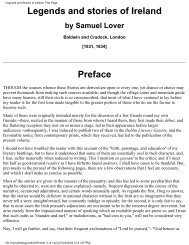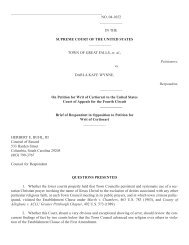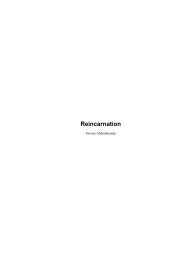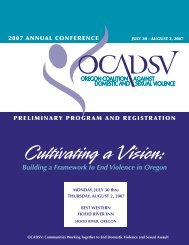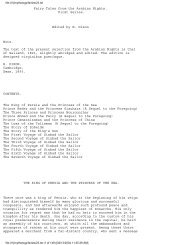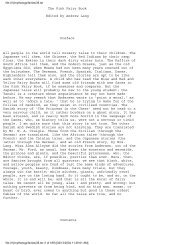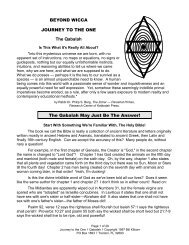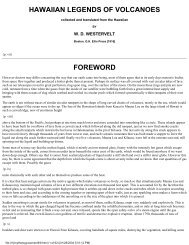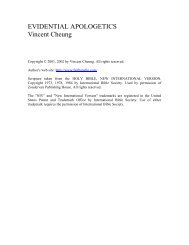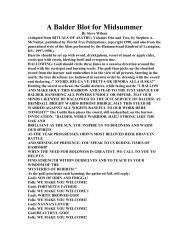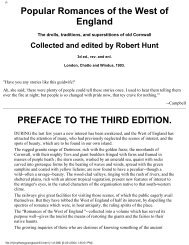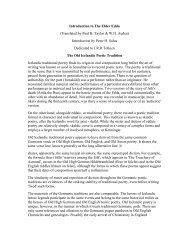Irish Druids And Old Irish Religions PREFACE CONTENTS
Irish Druids And Old Irish Religions PREFACE CONTENTS
Irish Druids And Old Irish Religions PREFACE CONTENTS
Create successful ePaper yourself
Turn your PDF publications into a flip-book with our unique Google optimized e-Paper software.
Erinn before the coming of the faith."<br />
p. 15<br />
Among the names of <strong>Druids</strong> we have, in Cormac's Glossary, Serb, daughter of Scath, a Druid of the Connaught men; Munnu, son of<br />
Taulchan the Druid; and Druien, a Druid prophesying bird. D. O. Murrim belonged to Creag-a-Vanny hill; Aibhne, or Oibhne, to<br />
Londonderry. We read of Trosdan, Tages, Cadadius, Dader, Dill, Mogruth, Dubcomar, Firchisus, Ida, Ono, Fathan, Lomderg the bloody<br />
hand, and Bacrach, or Lagicinus Barchedius, Arch-druid to King Niall.<br />
Druidesses were not necessarily wives of <strong>Druids</strong>, but females possessed of Druidical powers, being often young and fair.<br />
Some names of Druidesses have been preserved; as Geal Chossach, or Cossa, white-legged, of Inisoven, Donegal, where her grave is still<br />
pointed out to visitors. There was Milucradh, Hag of the Waters, reported to be still living, who turned King Fionn into an old man by<br />
water from Lake Sliabh Gullin. Eithne and Ban Draoi were famous sorcerers. Tradition talks of Women's Isles of Ireland, as of Scotland,<br />
where Druidesses, at certain festivals, lived apart from their husbands, as did afterwards Culdee wives at church orders. On St. Michael, on<br />
Sena Isle of Brittany, and elsewhere, such religious ladies were known. Scotch witches in their reputed powers of transformation were<br />
successors of Druidesses.<br />
Several ancient nunneries are conjectured to have been Druidesses' retreats, or as being established at such hallowed sites. At Kildare, the<br />
retreat of St. Brigid and her nuns, having charge of the sacred fire, there used to be before her time a community of <strong>Irish</strong> Druidesses,<br />
virgins, who were called, from their office, Ingheaw <strong>And</strong>agha, Daughters of Fire. The well-known Tuam, with its nine score nuns, may be<br />
an instance, since the word Cailtach means either nun or Druidess. On this, Hackett remarks, "The<br />
p. 16<br />
probability is that they were pagan Druidesses." Dr. O'Connor notes the Cluan-Feart, or sacred Retreat for Druidical nuns. It was decidedly<br />
dangerous for any one to meddle with those ladies, since they could raise storms, cause diseases, or strike with death. But how came Pliny<br />
to say that wives of <strong>Druids</strong> attended certain religious rites naked, but with blackened bodies? Enchantresses, possessed of evil spirits, like<br />
as in ancient Babylon, or as in China now, were very unpleasant company, and a source of unhappiness in a family.<br />
The Rev. J. F. Shearman declared that Lochra and Luchadmoel were the heads of the <strong>Druids</strong>' College, prophesying the coming of the<br />
Talcend (St. Patrick), that the first was lifted up and dashed against a stone by the Saint, the other was burnt in the ordeal of fire at Tara,<br />
that the Druid Mautes was he who upset the Saint's chalice, and that Ida and Ona were two converted <strong>Druids</strong>.<br />
The Synod of Drumceat, in 590, laid restrictions on <strong>Druids</strong>, but the <strong>Druids</strong> were officially abolished after the decisive Battle of Moyrath,<br />
637. The bilingual inscription of Killeen, Cormac--IV VERE DRVVIDES, or "Four True <strong>Druids</strong>," was said to refer to Dubhtach<br />
Macnlugil as one of the four, he having been baptized by Patrick.<br />
Dr. Richey may be right, when he says in his History of the <strong>Irish</strong> People:--"Attempts have been made to describe the civilization of the<br />
<strong>Irish</strong> in pre-Christian periods, by the use of the numerous heroic tales and romances which still survive to us; but the Celtic epic is not<br />
more historically credible or useful than the Hellenic,--the Tam Bo than the Iliad." It is probable that the readers of the foregoing tales, or<br />
those hereafter to be produced, may be of the same opinion Not even the prophecy of St Patrick's advent can be exempted, though the<br />
Fiacc Hymn runs --<br />
p. 17<br />
"For thus had their prophets foretold then the coming<br />
Of a new time of peace would endure after Tara<br />
Lay desert and silent, the <strong>Druids</strong> of Laery<br />
Had told of his coming, had told of the Kingdom."<br />
Ireland had a supply of the so-called Druidical appendages and adornments. There have been found golden torques, gorgets, armillæ and<br />
rods, of various sorts and sizes. Some were twisted. There were thin laminae of gold with rounded plates at the ends. Others had<br />
penannular and bulbous terminations. Twisted wire served for lumbers or girdle-torques. A twisted one of gold, picked up at Ballycastle,<br />
weighed 22 oz. Gorgets are seen only in Ireland and Cornwall. The Dying Gladiator, in Rome, has a twisted torque about his neck.<br />
The gold mines of Wicklow doubtless furnished the precious metal, as noted in Senchus Mor. Pliny refers to the golden torques of <strong>Druids</strong>.<br />
One, from Tara, was 5 ft. 7 in. long, weighing 27 ozs. A Todh, found twelve feet in a Limerick bog, was of thin chased gold, with concave<br />
hemispherical ornaments. The Iodhan Moran, or breastplate, would contract on the neck if the judges gave a false judgment. The crescent<br />
ornament was the <strong>Irish</strong> Cead-rai-re, or sacred ship, answering to Taliesin's Cwrwg Gwydrin, or glass boat. An armilla of 15 ozs. was<br />
recovered in Galway. The glass beads, cylindrical in shape. found at Dunworley Bay, Cork, had, said Lord Londesborough, quite a Coptic<br />
character. The Druid glass is Gleini na Droedh in Welsh, Glaine nan Druidhe in <strong>Irish</strong>.<br />
The Dublin Museum--<strong>Irish</strong> Academy collection--contains over three hundred gold specimens. Many precious articles had been melted<br />
down for their gold. The treasure trove regulations have only existed since 1861. Lunettes are common The <strong>Druids</strong>' tiaras were semi-oval,<br />
in thin plates, highly embossed. The golden breast-pins, Dealg Oir, are rare. Some armillæ are solid, others hollow. Fibulæ<br />
p. 18<br />
file:///I|/mythology/witchcraft/8/8.html (8 of 114) [02/05/2004 8:38:13 AM]



